BY STEVE JOHNSON ()
Devices for teaching electronics have a history dating back to the beginning of the last century. In the early 1900s, almost every major city across the U.S. had a telegraph school. These schools taught basic electricity, telegraph theory and operation, and Morris code (a.k.a. Morse code). When radio became popular in the early 1920s, many of these schools switched to or added “wireless” training to their curriculum. As radio became mainstream hundreds of radio service training schools sprang up across the country promising lucrative careers in the new radio service industry.
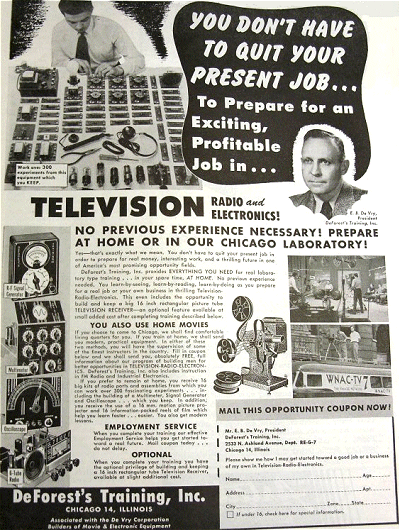
DeForest's Training School's advertisements appeared in many electronic, radio, and science publications.
Many of these new training schools operated from a central location and offered home training courses through the mail. Throughout the 1950s it was hard to open any radio/TV, electronics, or science magazine and not see several ads for home training courses that promised a bright future in electronic service. As part of the training, many schools provided kits to build test equipment, which the student could then use after completing the training course. These kits provided hands-on soldering skills as well as providing students with meters, vacuum tube testers, and oscilloscopes they could use in their new electronics service career.
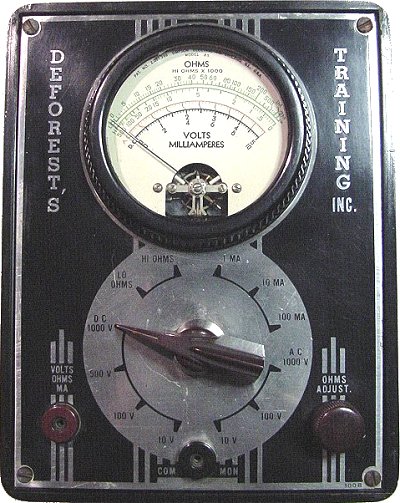
A 1950s Deforest's Training Inc. Multimeter .
One of the problems training schools and engineers alike faced when teaching and designing circuits was soldering and unsoldering components. Early training and test circuits were assembled by driving nails into a wooden board and wrapping the component leads around the nails. In many cases the leads would have to be soldered to make a good electrical connection. A way was needed to easily connect electrical components in a test circuit without having to constantly wrap or solder and unsolder every connection. In 1964, Ruben E. Cruz was awarded patent 3145483 for what is most likely the first solderless breadboard. By placing a transparent plastic board directly over a circuit diagram, component leads could be inserted into the board directly over their corresponding location on the circuit diagram.
The solderless breadboard design was taken a step further in 1971 by Ronald Portugal of EI Instruments Inc. This newer design, which is still used today for training and circuit prototyping, is the most common type of solderless breadboard. It usually consists of groups of five electrically connected sockets organized in rows allowing component leads, through hole integrated circuits, and jumper wires to be inserted and removed without wrapping or soldering any connections. These rows can then be connected together by inserting small jumper wires.
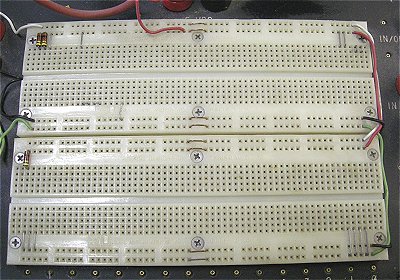
A pair of common solderless breadboards.
It was not long before training schools and designers incorporated these boards into cases which also contain onboard power supplies, function and pulse generators, switch banks, LED indicators, and many other commonly used components. Today standalone breadboards may be purchased starting at under $10 with training or design kits offering built-in generators, power supplies, and many newer features ranging into hundreds of dollars. Still these kits are less costly and take much less bench space than having each individual piece of gear. A used analog or digital trainer is a great addition to a hobbyist's bench.
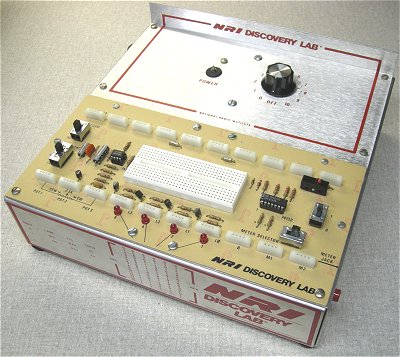
A simple breadboard trainer from NRI.
National Radio Institute's “NRI Discovery Lab” incorporated fixed-voltage power supplies, a simple function generator, and other commonly used components in addition to a breadboard. The student was supplied all the components and case along with assembly instructions. Due to the small work area of the single breadboard and the fixed voltage power supplies there is not much demand for this NRI model outside of the actual training course. I would expect a used NRI Discovery Lab to sell for only between $20 and $40. Of course, you can use external power supplies and meters with any bread board.
Heathkit was well known for its popular electronic kits. Just about every type of consumer electronics was available in kit form from Heathkit, including radios, televisions, and amplifiers, to name just a few. Heathkit also supplied analog and digital breadboard trainers to schools and industry. Heathkit analog trainers are the most commonly found breadboard trainers on auction sites today.
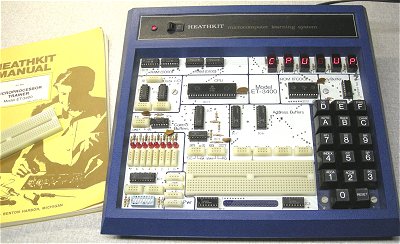
Heathkit ET-3400 Microprocessor Trainer
The Heathkit ET-3400 Microprocessor Trainer was designed in the late 1970s to teach microprocessor operation, programming, and applications. It was also suited for developing and testing microprocessor based software. Based on the 6800 microprocessor, the trainer contained a solderless breadboard, full hexadecimal keypad, and a 6-digit hexadecimal display. It also contained data switches, LEDs for monitoring logic states, and internal dc power supplies.
Although the ET-3400 is not well suited for designing and testing analog circuits, it is a popular item sought after by vintage computer collectors. A complete working unit including all the keypad keys and the original manual ranges in value from $80 to $150 depending on condition.
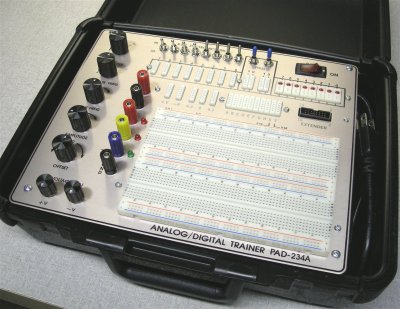
RSR Analog/Digital Trainer
One of my favorite breadboard trainers is the RSR PAD-234A. Originally released in the mid 1990s, the RSR PAD-234A is still a popular cost-effective training and design breadboard. it contains a large, well marked, solderless breadboard with over 1,600 tie points along with fixed and variable dc power supplies and a ±6.3-V ac supply. It has a built in function generator with controls for course and fine frequency, amplitude, and offset. A set of five-way binding posts allows for bare wire and banana test lead connections. It has eight buffered LED indicators along with eight SPDT toggle switches and two momentary switches that can supply 0 and 5 V for digital circuits. The unit may also be found in a plastic carrying case. This solderless trainer series was first produced in the mid 1990s so they are fairly easy to find on popular auction sites. They typically range in price from $40 to $100 depending on condition. If you don't want to risk purchasing one in unknown condition, the PAD-234A is available new in kit form or fully assembled from the manufacturer's web site http://www.elexp.com
Solderless breadboards remain popular with hobbyists, training intuitions, and designers even though today's integrated circuits and components are moving toward surface-mount designs and away from through-hole construction.
For more information and examples of early electronic technology, view my collection at StevesAntiqueTechnology.com
Advertisement
Learn more about Electronic Products Magazine





